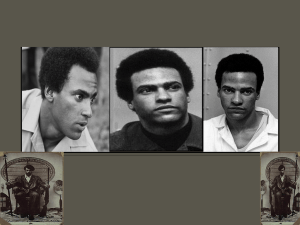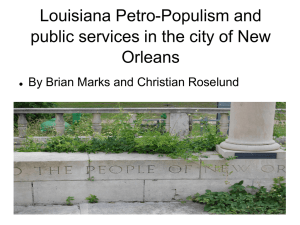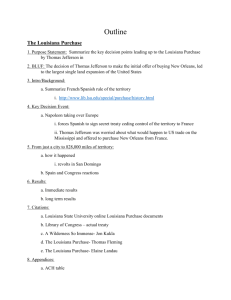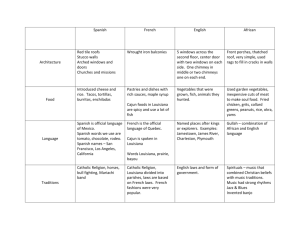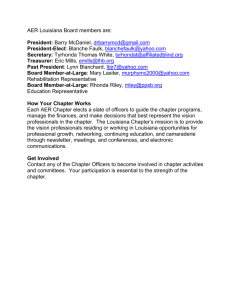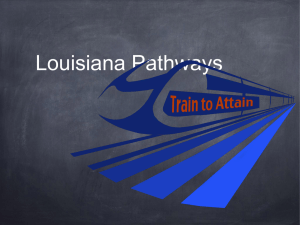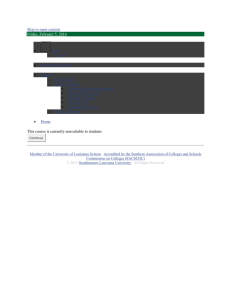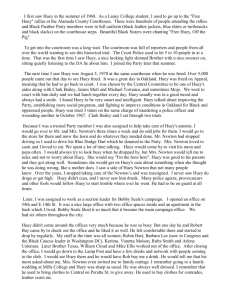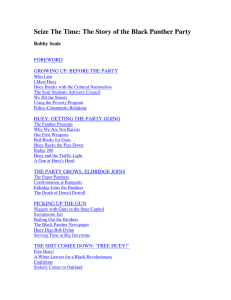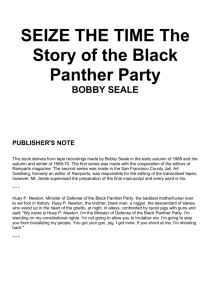Task - Social Studies - Grade 8 - Huey Long
advertisement
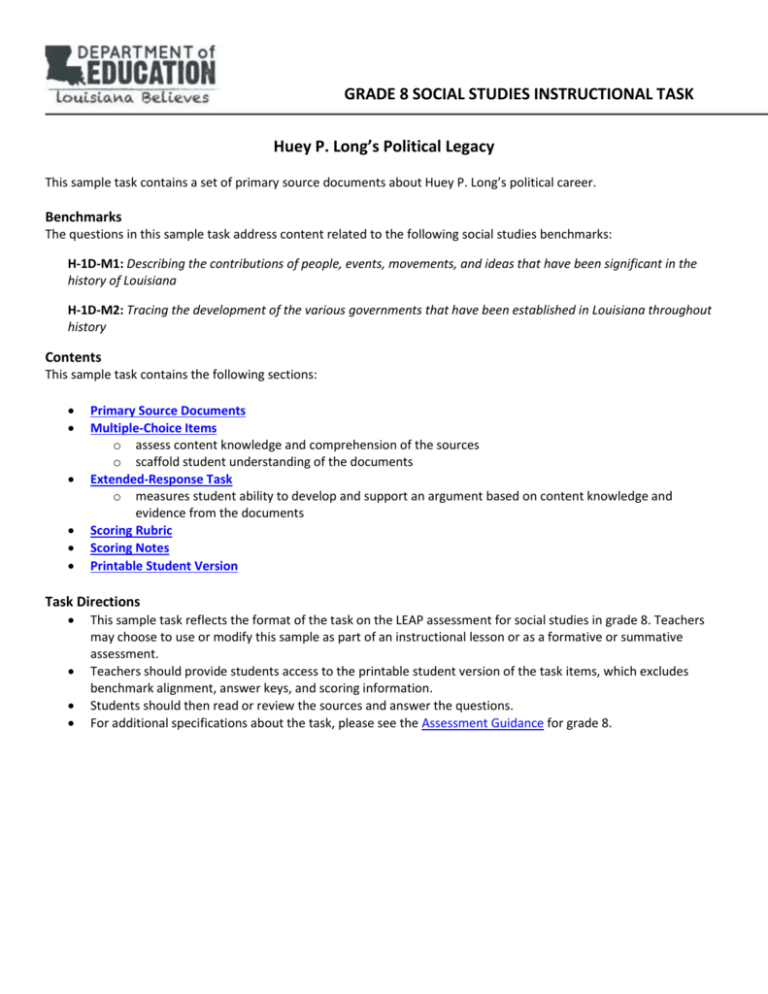
GRADE 8 SOCIAL STUDIES INSTRUCTIONAL TASK Huey P. Long’s Political Legacy This sample task contains a set of primary source documents about Huey P. Long’s political career. Benchmarks The questions in this sample task address content related to the following social studies benchmarks: H-1D-M1: Describing the contributions of people, events, movements, and ideas that have been significant in the history of Louisiana H-1D-M2: Tracing the development of the various governments that have been established in Louisiana throughout history Contents This sample task contains the following sections: Primary Source Documents Multiple-Choice Items o assess content knowledge and comprehension of the sources o scaffold student understanding of the documents Extended-Response Task o measures student ability to develop and support an argument based on content knowledge and evidence from the documents Scoring Rubric Scoring Notes Printable Student Version Task Directions This sample task reflects the format of the task on the LEAP assessment for social studies in grade 8. Teachers may choose to use or modify this sample as part of an instructional lesson or as a formative or summative assessment. Teachers should provide students access to the printable student version of the task items, which excludes benchmark alignment, answer keys, and scoring information. Students should then read or review the sources and answer the questions. For additional specifications about the task, please see the Assessment Guidance for grade 8. GRADE 8 SOCIAL STUDIES INSTRUCTIONAL TASK Primary Source Documents Read and study Documents 1 through 5 about Huey P. Long’s political career. Think about how he changed Louisiana and why his actions created controversy. As you read, you may take notes in the space next to the documents or on page XX in this answer document. Then use the documents to answer questions 1 through 5. Document 1: Senator Huey P. Long, Statement of the Share Our Wealth Movement, May 23, 1935. In Congressional Record, 74th Cong., 1st sess., Vol. 79, 8040-43. Here is the whole sum and substance of the share-our-wealth movement: Document 2: Map Nile by the Government a homestead allowance, free of debt, of not less than one-third 1. Every family toof bethe furnished http://www.mummies2pyramids.info/geography-cities/geography-cities-index.htm the average family wealth of the country, which means, at the lowest, that every family shall have the reasonable comforts of life up to a value of from $5,000 to $6,000. No person to have a fortune of more than 100 to 300 times the average family fortune, which means that the limit to fortunes is between $1,500,000 and $5,000,000, with annual capital levy taxes imposed on all above $1,000,000. 2. The yearly income of every family shall be not less than one-third of the average family income, which means that, according to the estimates of the statisticians of the United States Government and Wall Street, no family's annual income would be less than from $2,000 to $2,500. No yearly income shall be allowed to any person larger than from 100 to 300 times the size of the average family income, which means that no person would be allowed to earn in any year more than from $600,000 to $1,800,000, all to be subject to present income-tax laws. 3. To limit or regulate the hours of work to such an extent as to prevent overproduction; the most modern and efficient machinery would be encouraged, so that as much would be produced as possible so as to satisfy all demands of the people, but to also allow the maximum time to the workers for recreation, convenience, education, and luxuries of life. 4. An old-age pension to the persons over 60. 5. To balance agricultural production with what can be consumed according to the laws of God, which includes the preserving and storage of surplus commodities to be paid for and held by the Government for the emergencies when such are needed. Please bear in mind, however, that when the people of America have had money to buy things they needed, we have never had a surplus of any commodity. This plan of God does not call for destroying any of the things raised to eat or wear, nor does it countenance wholesale destruction of hogs, cattle, or milk. 6. To pay the veterans of our wars what we owe them and to care for their disabled. 7. Education and training for all children to be equal in opportunity in all schools, colleges, universities, and other institutions for training in the professions and vocations of life; to be regulated on the capacity of children to learn, and not on the ability of parents to pay the costs. Training for life's work to be as much universal and thorough for all walks in life as has been the training in the arts of killing. 8. The raising of revenue and taxes for the support of this program to come from the reduction of swollen fortunes from the top, as well as for the support of public works to give employment whenever there may be any slackening necessary in private enterprise. GRADE 8 SOCIAL STUDIES INSTRUCTIONAL TASK Document 2: Political cartoon from Huey P. Long’s Louisiana Progress newspaper, 1930 http://www.hueylong.com/programs/education.php (Right column, second image; click to enlarge) Document 3: Excerpt from Huey P. Long’s obituary, New York Times, September 11, 1935 http://www.digitalhistory.uh.edu/disp_textbook.cfm?smtID=3&psid=1162 (Bottom of page, #4; shorten length by removing first paragraph) Document 4: Political cartoon depicting Huey P. Long, 1932 http://louisdl.louislibraries.org/cdm/singleitem/collection/HPL/id/153/rec/34 Document 5: Campaign poster, 1940 http://hueylong.com/legacy/new-louisiana.php (Right column, second image; click to enlarge) GRADE 8 SOCIAL STUDIES INSTRUCTIONAL TASK Multiple-Choice Items History Louisiana History H-1D-M1: Describing the contributions of people, events, movements, and ideas that have been significant in the history of Louisiana 1 Which statement best explains why Huey P. Long’s “Share Our Wealth” movement (Document 1) appealed to so many Americans during the 1930s? A B C D Many Americans were concerned about the budget deficit. Many Americans were concerned their taxes would increase. Many Americans were concerned about the state of the economy. Many Americans were concerned the government was too powerful. Correct response: C History Louisiana History H-1D-M1: Describing the contributions of people, events, movements, and ideas that have been significant in the history of Louisiana 2 In Document 4, Huey P. Long is portrayed in the costume of Napoleon Bonaparte. Which statement best explains the cartoonist’s purpose in making this artistic choice? A B C D to describe Long as insane to characterize Long as a dictator to frighten citizens into obeying Long to applaud Long for his accomplishments Correct response: B GRADE 8 SOCIAL STUDIES INSTRUCTIONAL TASK History Louisiana History H-1D-M1: Describing the contributions of people, events, movements, and ideas that have been significant in the history of Louisiana 3 In Document 3, the New York Times writes, “Senator Long's career is also a reminder that material for the agitator and the demagogue is always ample in this country.” Which statement best describes the connotation for the word “demagogue” as it is used in Document 3? A B C D a leader who preys on the ignorance of the lower classes a leader who misleads the citizenry about his presidential ambitions a leader who shifts his political positions to reflect the public’s wishes a leader who enacts policies to improve the lives of the common people Correct response: A History Louisiana History H-1D-M2: Tracing the development of the various governments that have been established in Louisiana throughout history 4 Why was Huey P. Long’s administration considered a significant break from prior Louisiana governments? A B C D His administration openly courted fascist supporters. His administration was devoted to cleaning up corruption. His administration practiced economy to balance the budget. His administration vastly expanded the role of state government. Correct response: D GRADE 8 SOCIAL STUDIES INSTRUCTIONAL TASK Extended-Response Task History Louisiana History H-1D-M1: Describing the contributions of people, events, movements, and ideas that have been significant in the history of Louisiana 5 Write a well-organized response on the lines provided on pages XX and XX in this answer document. Evaluate Huey P. Long’s political legacy. Consider the following questions when writing your response: Why was he a controversial political figure? What lasting changes did he create in Louisiana? As you write, follow the directions below. Your response should have multiple paragraphs, begin with an introduction, and end with a conclusion. Use evidence from each of the documents to support your claims. Include information and examples from your own knowledge of social studies. Be sure to write clearly. Use page XX in this answer document for notes and planning. Write your final response on pages XX and XX in this answer document. Remember: The prewriting activities on page XX will not be scored. Only your response on pages XX and XX will be scored. GRADE 8 SOCIAL STUDIES INSTRUCTIONAL TASK Scoring Rubric The response should be scored holistically on its analysis and content. Each response should be given the score that corresponds to the set of bulleted descriptors that best describes the response. Score 4 3 2 1 0 Social Studies Task Rubric—Huey P. Long The student’s response constructs a sophisticated argument that provides an in-depth evaluation of Huey P. Long’s political legacy; supports the claims with ample, well-chosen evidence that o addresses or demonstrates understanding of at least four of the documents, and o integrates adequate relevant information beyond what is provided in the documents; contains valid historical understandings and interpretations with no errors significant enough to detract from the argument. The student’s response constructs an acceptable argument that provides an in-depth evaluation of Huey P. Long’s political legacy; supports the claims with sufficient and appropriate evidence that o addresses or demonstrates understanding of three of the documents, and o integrates some relevant information beyond what is provided in the documents; contains mostly valid historical understandings and interpretations, although less important ideas or details may be overlooked or misunderstood. The student’s response constructs a weak and/or flawed argument that provides a limited or partial evaluation of Huey P. Long’s political legacy; supports the claims with limited and/or uneven evidence that o addresses or demonstrates understanding of two of the documents, and o integrates limited relevant information beyond what is provided in the documents; contains some valid historical understandings and interpretations, but a few significant errors may be present. The student’s response must include at least one valid historical understanding or interpretation that addresses the prompt and is stated in the student’s own words; must demonstrate a minimal understanding of the topic; may contain several significant errors. The student’s response is incorrect, irrelevant, or too brief to evaluate. GRADE 8 SOCIAL STUDIES INSTRUCTIONAL TASK Scoring Notes A strong response references the documents appropriately: o professed goals of the “Share Our Wealth” movement (Document 1) o provision of free textbooks for schools (Document 2) o establishment of the Louisiana Progress (later renamed American Progress) newspaper to publish the Long machine’s propaganda (Document 2) o Long’s reputation among his opponents as a demagogue and dictator who relied on intimidation (Documents 3 and 4) o Long’s preservation of his power in state government after being elected to the US Senate (Document 3) o Earl Long’s attempt to appropriate Huey P. Long’s legacy (Document 5), despite their past differences o endurance of the Long machine in Louisiana after Long’s death (Document 5) includes additional information about Huey P. Long’s political legacy, such as: o Long’s early career as an opponent of Standard Oil and how he continued to cross swords with the corporation while in office o Long’s successful bridging of the North/South Louisiana cultural and religious divides in the 1928 gubernatorial election o from 1928-1960, the existence of pro-Long and anti-Long factions; created the effect of a two-party system in Louisiana in the era of the “Solid South” o the state legislature’s failed impeachment attempt after Long’s proposed increase in the oil severance tax; Long’s retaliation against his opponents afterward o Long’s impact on national politics national appeal of the “Share Our Wealth” movement (7.5 million members in 27,000 clubs by 1935) first a supporter and then a vocal critic of President Franklin D. Roosevelt FDR’s shift to the left FDR’s retaliation (giving federal patronage to Long’s enemies and investigating Long and his allies for tax evasion) Long’s open presidential ambitions o Long’s policies in Louisiana support for adult literacy programs expansion of Louisiana State University (increased funding, higher enrollment, lower tuition, scholarships, establishment of LSU medical school) unprecedented infrastructure construction (over 1,200 miles of paved roads, bridges, schools, hospitals, airport in New Orleans, new state capitol) public health improvements (construction of Charity Hospital, reform of state mental institutions, free immunizations, medical and dental care for prison inmates) elimination of the poll tax homestead exemption graduated income tax Debt Moratorium Act (prevented foreclosures) active prevention of bank closures o Long’s impact on the state budget programs paid for with taxes on business and industry as well as the general public bond indebtedness increased did not bankrupt the state, though, as critics claimed he would GRADE 8 SOCIAL STUDIES INSTRUCTIONAL TASK o o o o Long’s methods aggressive, innovative campaign tactics (radio addresses and commercials, stumping tours with rural stops, sound trucks, circulars, scathing attacks of opponents) purge of the state bureaucracy; use of patronage and “deduct box” (forced political contributions from state employees) withholding of authorization for Army Air Corps base in Shreveport when Caddo Parish refused free textbooks widespread intimidation of opponents refusal to vacate the governor’s seat after election to the US Senate until opponent removed from lieutenant governorship continued control of state government during O. K. Allen’s term in office consolidation of control over municipal agencies and boards, especially in New Orleans gerrymandering of election districts to favor Long candidates establishment of Bureau of Criminal Identification, a special police force answerable only to the governor attempts to censor the press (newspaper tax overturned by the US Supreme Court in Grosjean v. American Press Co. in 1936) the Louisiana Hayride scandals after Long’s assassination; imprisonment of Governor Leche the understanding that the historiography on Long continues to shift; he remains a highly controversial figure eight decades after his death Long’s legacy on racial issues (remains contentious) According to T. Harry Williams’s 1969 Pulitzer Prize-winning biography, Long did not engage in the race-baiting typical of Southern politicians at the time, and because his programs were not exclusively for whites, many of his policies improved the lives of African Americans. Subsequent historians in the 1990s portrayed Long as, indeed, a typical Southern demagogue of the time, seeking to dispel Williams’s argument. Printable Student Version *Note: Some sources are available only in digital format. A link is provided and will require the use of a computer to view the source. Huey P. Long’s Political Legacy Read and study Documents 1 through 5 about Huey P. Long’s political career. Think about how he changed Louisiana and why his actions created controversy. As you read, you may take notes in the space next to the documents or on page 5 in this answer document. Then use the documents to answer questions 1 through 5. Document 1: Senator Huey P. Long, Statement of the Share Our Wealth Movement, May 23, 1935. In Congressional Record, 74th Cong., 1st sess., Vol. 79, 8040-43. Here is the whole sum and substance of the share-our-wealth movement: Document 2: Map Nile by the Government a homestead allowance, free of debt, of not less than one-third 1. Every family toof bethe furnished http://www.mummies2pyramids.info/geography-cities/geography-cities-index.htm the average family wealth of the country, which means, at the lowest, that every family shall have the reasonable comforts of life up to a value of from $5,000 to $6,000. No person to have a fortune of more than 100 to 300 times the average family fortune, which means that the limit to fortunes is between $1,500,000 and $5,000,000, with annual capital levy taxes imposed on all above $1,000,000. 2. The yearly income of every family shall be not less than one-third of the average family income, which means that, according to the estimates of the statisticians of the United States Government and Wall Street, no family's annual income would be less than from $2,000 to $2,500. No yearly income shall be allowed to any person larger than from 100 to 300 times the size of the average family income, which means that no person would be allowed to earn in any year more than from $600,000 to $1,800,000, all to be subject to present income-tax laws. 3. To limit or regulate the hours of work to such an extent as to prevent overproduction; the most modern and efficient machinery would be encouraged, so that as much would be produced as possible so as to satisfy all demands of the people, but to also allow the maximum time to the workers for recreation, convenience, education, and luxuries of life. 4. An old-age pension to the persons over 60. 5. To balance agricultural production with what can be consumed according to the laws of God, which includes the preserving and storage of surplus commodities to be paid for and held by the Government for the emergencies when such are needed. Please bear in mind, however, that when the people of America have had money to buy things they needed, we have never had a surplus of any commodity. This plan of God does not call for destroying any of the things raised to eat or wear, nor does it countenance wholesale destruction of hogs, cattle, or milk. 6. To pay the veterans of our wars what we owe them and to care for their disabled. 7. Education and training for all children to be equal in opportunity in all schools, colleges, universities, and other institutions for training in the professions and vocations of life; to be regulated on the capacity of children to learn, and not on the ability of parents to pay the costs. Training for life's work to be as much universal and thorough for all walks in life as has been the training in the arts of killing. 8. The raising of revenue and taxes for the support of this program to come from the reduction of swollen fortunes from the top, as well as for the support of public works to give employment whenever there may be any slackening necessary in private enterprise. 1 Document 2: Political cartoon from Huey P. Long’s Louisiana Progress newspaper, 1930 http://www.hueylong.com/programs/education.php (Right column, second image; click to enlarge) Document 3: Excerpt from Huey P. Long’s obituary, New York Times, September 11, 1935 http://www.digitalhistory.uh.edu/disp_textbook.cfm?smtID=3&psid=1162 (Bottom of page, #4; shorten length by removing first paragraph) Document 4: Political cartoon depicting Huey P. Long, 1932 http://louisdl.louislibraries.org/cdm/singleitem/collection/HPL/id/153/rec/34 Document 5: Campaign poster, 1940 http://hueylong.com/legacy/new-louisiana.php (Right column, second image; click to enlarge) 2 1 Which statement best explains why Huey P. Long’s “Share Our Wealth” movement (Document 1) appealed to so many Americans during the 1930s? A B C D 2 In Document 4, Huey P. Long is portrayed in the costume of Napoleon Bonaparte. Which statement best explains the cartoonist’s purpose in making this artistic choice? A B C D 3 Many Americans were concerned about the budget deficit. Many Americans were concerned their taxes would increase. Many Americans were concerned about the state of the economy. Many Americans were concerned the government was too powerful. to describe Long as insane to characterize Long as a dictator to frighten citizens into obeying Long to applaud Long for his accomplishments In Document 3, the New York Times writes, “Senator Long's career is also a reminder that material for the agitator and the demagogue is always ample in this country.” Which statement best describes the connotation for the word “demagogue” as it is used in Document 3? A B C D 4 a leader who preys on the ignorance of the lower classes a leader who misleads the citizenry about his presidential ambitions a leader who shifts his political positions to reflect the public’s wishes a leader who enacts policies to improve the lives of the common people Why was Huey P. Long’s administration considered a significant break from prior Louisiana governments? A B C D His administration openly courted fascist supporters. His administration was devoted to cleaning up corruption. His administration practiced economy to balance the budget. His administration vastly expanded the role of state government. 3 5 Write a well-organized response on the lines provided on pages 6 and 7 in this answer document. Evaluate Huey P. Long’s political legacy. Consider the following questions when writing your response: Why was he a controversial political figure? What lasting changes did he create in Louisiana? As you write, follow the directions below. Your response should have multiple paragraphs, begin with an introduction, and end with a conclusion. Use evidence from each of the documents to support your claims. Include information and examples from your own knowledge of social studies. Be sure to write clearly. Use page 5 in this answer document for notes and planning. Write your final response on pages 6 and 7 in this answer document. Remember: The prewriting activities on page 5 will not be scored. Only your response on pages 6 and 7 will be scored. 4 Use for notes and planning your response. (This page will not be scored.) 5 5. Final Response 6 7
